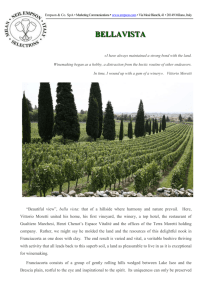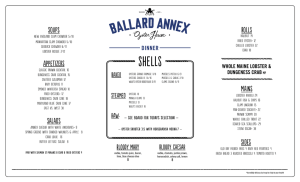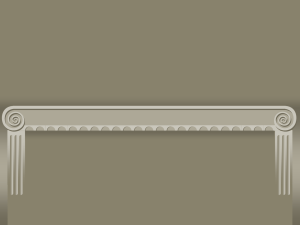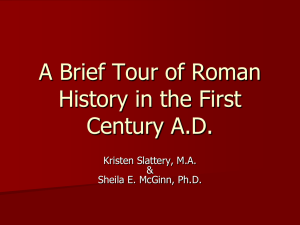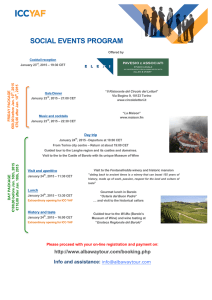Ferghettina Powerpoint
advertisement
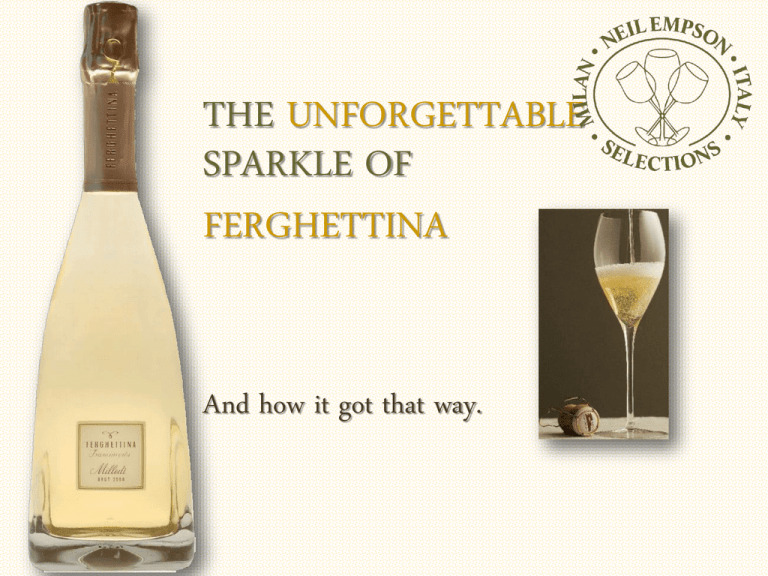
THE UNFORGETTABLE SPARKLE OF FERGHETTINA And how it got that way. The Franciacorta identity is now secure: quite simply, the finest Champenois-method sparkling wine in Italy. Or, in politically correct terms, the country’s finest Metodo Classico (the EU forbids using the word Champenois elsewhere than in Champagne). The appellation’s history is a bit of a paradox: for all the name’s antiquity, its fame is as young and fresh as Franciacorta perlage. Franciacorta comes from Medieval Latin curtes francae, referring to the Benedictine friaries (“curtes”) that were allowed to exchange goods, dutyfree (“francae”). These temperate climes and glacial morainic hills south of Lake Iseo provided the friars with ideal conditions for grape-growing and winemaking, just as they had done for centuries before then. SATELLITE VIEW OF FRANCIACORTA AND LAKE ISEO Note: Yellow bubbles on satellite map point to Adro, Ferghettina location. In 1277, we find the name Curtes Francae has become Franzacurta, which turns into Franciacorta much, much later. The wines we are talking about so far, however, are still ones. We must fast forward to 1961 to get the first spumante labeled Franciacorta: a limited bottling of only 3,000 items. From the original 3,000 bottles to the 15 million bottles of today; from the DOC of 1967 to the Garantita of 1995, those first tiny bubbles of Franciacorta snowballed into a quality avalanche, redesigning the appellation and even revolutionizing the extant categories and names. If the norms of ’67 allowed for both Franciacorta still and sparkling wines, the DOCG ones in ’95 made sure that only Metodo Classico sparkling wines from the region could be labeled Franciacorta – just as there is no still version of Champagne. (Also like Champagne and its AOC, Franciacorta labels can do without their DOCG wording: the only Italian wine to enjoy this privilege.) View of Lake Iseo The still wines are now called Curtefranca, another ancient name for the area. The new denomination simultaneously maintained territorial identity and created a firm distinction between the two facets of Franciacorta, bollicine and tranquilli. Franciacorta sparkle is a happy combination of nature and nurture: the unique terroir – wellThe Franciacorta appellation and districts. The story of Roberto Gatti, Ferghettina founder, goes from Cazzago San Martino to Erbusco, to Adro... draining glacial moraines whose microclimate is tempered by the vast lakes – is ideally suited to Chardonnay, Pinot Bianco and Pinot Nero and their bubbly incarnations. That’s nature. At the same time, on the nurture front, Franciacorta belongs to the country’s richest region, Lombardy. This means the quality avalanche of Metodo Classico attracted money, The new Ferghettina winery... Looking timeless entrepreneurs, major investments, all of which are essential to this costly production method. In this somewhat daunting context, there is one very fine winery, favorably located close to Lake Iseo, which has managed to combine excellence, avant-garde research and a warm-hearted, family feel not easily come by in the area: Roberto Gatti’s Ferghettina. Roberto, wife Andreina and their enologist children, Laura and Matteo, form a young, enthusiastic, friendly and forward-thinking team whose growth is as sure, bright and lively as that of the winery’s adorable mascot, Laura’s little Pietro. The family: L to R, Laura, Andreina, Roberto, Matteo Gatti Laura with baby Pietro When we were still in the exploratory phase, before meeting Roberto and his family, we read, researched and tasted. Out of all we read, two comments stuck in particular. One came straight from Laura Gatti, Roberto’s daughter: “Our winery is a family.” The other belongs to one of Italy’s most highly respected food & wine writers, Francesco Arrigoni, whose premature demise, at The winery and adjacent, baby olive trees and vine rows 52, left the industry reeling in August 2011. In an article for the leading national newspaper, Corriere della Sera, (still available online at http://webwinefood.corriere.it/2011/04/06/la_quadratura_del_ franciaciaco/), Arrigoni expressed his admiration for the Ferghettina winery and the people behind it: “Roberto Gatti is no ordinary man; he’s a force of nature, one of the hardestworking guys I’ve ever met, and a man of the vineyard since the day he was born.” The winery was built in 2002-’05 yet has all the feel and appearance of a traditional local farm “True,” Laura nods and smiles, “my father is 59 years old and spent a good 50 of these in the vineyards and winery.” Roberto Gatti literally worked his way to the top: born in Franciacorta, at Cazzago San Martino, to sharecropper and grape-growing parents, he moved a little northwest to Erbusco, where he became the cellarmaster and vineyard manager to an important Franciacorta producer and stayed on some 20 years. In 1990, he began to give an elderly family friend a helping hand over weekends: the woman owned a tiny winery and after her husband’s death, had a hard time dealing with the details of production. At the time, she sold in bulk but one year into the collaboration, she was so impressed she offered to sell him the winery and adjacent three hectares (7.4 acres) under vine, convinced production would shine in Roberto’s hands. The year was 1991: Gatti left his former employer and struck out on his own – Ferghettina was born, named after the place name where the winery was located. For the first time, production was bottled under the Ferghettina label and Gatti’s first Franciacorta Brut was released in 1992. Inside the new winery, classic meets sleek modern design Ferghettina grew, step by step. After a lifetime in the vineyards, Roberto knew the best fruit ripens gradually. People in Franciacorta hold him in great liking and esteem, so that little by little, he took over new plots on long leases (20-25 years), which he replanted to the severest standards, eventually running a total of 180 hectares (445 acres) under vine, split into 9 Franciacorta districts. Only a small portion of these is proprietary, for the family policy is investing in top-quality equipment and vineyard management; not to mention the state-of-the-art, 64,600-square-foot new winery at Adro (again, slightly northwest of Erbusco), designed by Laura’s architect husband. Though built from 2002 to 2005, it is perfectly integrated into the landscape: made of timeless-looking bricks and stones and looking like a traditional farmhouse of the area, it embraces a gently sloping hill within sight of Lake Iseo (a.k.a. Lake Sebino). The Gatti family is supported by a staff of fifteen and yearly bollicine production is around 350,000 bottles. The wines are styled by Roberto himself with Laura and Matteo, both university graduates in enology. In fact, starting with the 2007 vintage, the Ferghettina Rosé and vintage Brut (now known as Milledì), come in a special bottle invented by Matteo Gatti, with a square rather than round base, rising pyramid-like with flat interior sides so that during Rosé’s and Milledì’s three years on the lees, the yeasts of second fermentation have two and a half times greater contact with the wine by comparison with traditional, round-based bottles. This leads to even greater finesse, flavors and aromas. In other words, originality, beauty and functionality. THE FRANCIACORTAS!!! FRANCIACORTA BRUT Milledì DOCG (Vintage): 100% Chardonnay from calcareous-clayey soil at 250 m (820 ft) above sea level; The spectacular wine librar y each vineyard is individually vinified and the cuvée is assembled the following spring. The wine rests on the lees for 36 months. Straw yellow, with gold-green hues and tiny, persistent perlage. On the palate, elegant notes of citrus fruit and minerally freshness, long finish. C. 20,000 bottles per year. The name stands for “one thousand days” on The riddling cellar the lees. FRANCIACORTA ROSÉ BRUT DOCG (Vintage): 100% Pinot Nero (Pinot Noir) from calcareousclayey soil at 250 m (820 ft) above sea level; each vineyard is individually vinified, with partial skin maceration so as to achieve the characteristic onionskin rose color. The cuvée is put together the following spring, and the wine rests on the lees for 36 months. Tiny, persistent perlage, very elegant aromas with notes of raspberries and blackberries, outstanding structure and length. C. 15,000 bottles per year. Ferghettina Marmonnier press with Pinot Nero grapes for the Rosé FRANCIACORTA SATÈN BRUT DOCG (Vintage): The Brut wording is actually redundant, for this blanc de blancs in the Satèn category (where pressure in the bottle has to be less than 5 bar, conducive to a satin-like, creamy softness) can only be released in its Brut version... 100% Chardonnay from calcareous-clayey soil at 250 m (820 ft) above sea level; each vineyard is individually vinified and the cuvée is assembled the following spring. The wine sojourns on the lees for 36 months and results in a brilliant yellow bollicine with minuscule, lingering perlage, great finesse and silky texture, distinct aromas of pastries and sugarcoated almonds, and a long finish. C. 20,000 regular bottles yearly, plus 2,000 Ferghettina Marmonnier press with Pinot Nero grapes for the Rosé Magnums. FRANCIACORTA BRUT DOCG (Non-Vintage): 95% Chardonnay + 5% Pinot Nero (Pinot Noir) from calcareous-clayey soil at 250 m (820 ft) above sea level; each vineyard is individually vinified and the cuvée is assembled the following spring. Sojourn on the lees is 2 years. Straw yellow, extremely fresh and persistent, notes of white flowers, nuts and sweet fruit. C. 190,000 regular bottles yearly plus 10,000 half-bottles and 8,000 Mags. Ferghettina Marmonnier press with Pinot Nero grapes for the Rosé FRANCIACORTA EXTRA BRUT DOCG (Vintage): 80% Chardonnay + 20% Pinot Nero from calcareous-clayey soil at 820 feet above sea level; the base wines from the distinct vineyards are assembled into a cuvée the spring subsequent to harvest and after scrupulous tastings, the blend is bottled and sojourns on the lees for 72 months. Golden in color, tiny, persistent perlage, very intense aromas of almonds, vanilla and candied fruit. Beautiful balance of delicacy and persistence. 8,000 bottles per annum, approximately. FRANCIACORTA PAS DOSÉ RISERVA 33 DOCG (Vintage): The pinnacle of production, this Riserva is 100% Chardonnay from calcareous-clayey soil at 820 feet above sea level; the base wines from the distinct vineyards are assembled into a cuvée the spring subsequent to harvest and after scrupulous tastings, the blend is bottled. Following dégorgement, the liqueur d’expédition employed contains no sugar; hence the Pas Dosé category. Sojourn sur lie is especially long: 80 months, over six and a half years. Brilliant golden in color, with particularly tiny, creamy, persistent perlage and intense, elegant aromas of candied fruit, bread crust and crisp, juicy apples and pears. Lush, fresh, distinctive depth, finesse and breed. C. 10,000 bottles yearly. Ferghettina Marmonnier press with Pinot Nero grapes for the Rosé ARRIVEDERCI From Nonno Roberto, little Pietro and the rest of us at FERGHETTINA.
